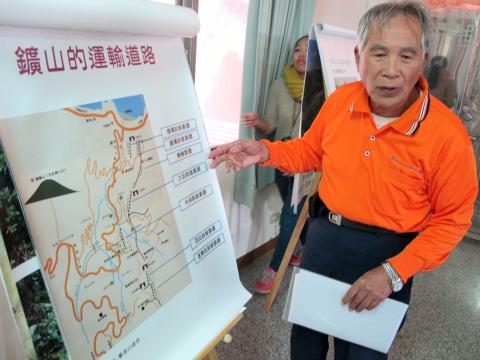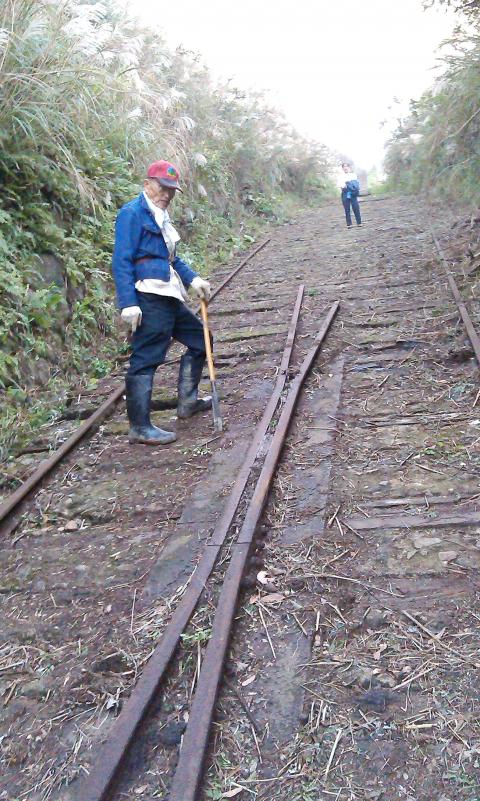Apparently inspired by the ancient Chinese proverb about an old man moving a mountain, for more than a year a group of elderly miners have been weeding, moving stones and paving roads to uncover an old mine railway, which was buried for the past 26 years in the former gold mining town of Jinguashih in New Taipei City’s Ruifang District. The group is urging the government to classify the area as an official historic site or historic building under the Cultural Heritage Preservation Act. The government is currently in the middle of the review process.
Cheng Chun-shan, an old Jinguashih miner, says that Taiwan Metals Mining Co shut down operations in 1987, and the railway fell into disuse, while the mine trolleys were auctioned off for scrap metal and the abandoned tracks were gradually overtaken by weeds and the wilderness.
Starting in October last year, four seniors — Cheng Chun-shan, Chen Shih-cheng, Lin Cheng-hsiung and Chang A-hui — along with dozens of other septuagenarians, commenced their project of “finding the road they once traversed.” With sickles and hoes in hand, they have walked the desolate hillside, chopping down weeds taller than themselves and clearing away boulders that fell down the hillside during typhoons. “We don’t have any particular agenda. We just want to locate the road again, which is part of Jinguashih residents’ collective memory,” Cheng says.

Photo: Yu Chao-fu, Liberty Times
照片:自由時報記者俞肇福
The hard work of the seniors has gradually received recognition from the government. Culture Minister Lung Ying-tai organized a team to survey the area on April 9, the New Taipei City Culture Affairs Department invited experts and academics to survey the area at the end of July, and an evaluation meeting was held on Dec. 6. A decision is expected to be made in the coming days as to whether the Jinguashih mine railway will be protected under the Cultural Heritage Preservation Act.
(Liberty Times, Translated by Kyle Jeffcoat)
金瓜石一群老礦工,用愚公移山的精神,歷經一年多的除草、清石、鋪路,讓消失廿六年的索道重見天日,呼籲官方依據文化資產保存法公告為「古蹟」或「歷史建築」保存,官方也進入審查程序。
金瓜石老礦工鄭春山說,一九八七年台金公司歇業,索道停止使用,台車被當廢鐵拍賣,而索道逐漸被荒煙蔓草覆蓋。

Photo courtesy of Cheng Chun-shan
照片由鄭春山提供
自去年十月開始,鄭春山、陳石成、林政雄、張阿輝四位及其他數十位平均年齡逾七十歲的老礦工,開始發起「把路走回來」行動,挽袖拿起鐮刀和鋤頭,走在荒煙蔓草的斜坡索道上,沿途割除比人還高的芒草,並整理因為颱風崩塌的土石;鄭春山說:「我們沒有甚麼特別的目的,只是想要找回這條路,找回屬於金瓜石人的記憶。」
老礦工的努力,逐漸被官方看見,今年四月九日,文化部部長龍應台率員探勘,七月下旬,新北市文化局也邀請專家學者實勘,本月六日召開評估會議,預計近日公告金水台車道是否納入文化資產保護範圍。
(自由時報記者李雅雯、俞肇福、賴筱桐)

The content recommendation algorithm that powers the online short video platform TikTok has once again come under the spotlight after the app’s Chinese owner ByteDance signed binding agreements to form a joint venture that will hand control of operations of TikTok’s US app to American and global investors, including cloud computing company Oracle. Here is what we know so far about its fate, following the establishment of the joint venture. IS BYTEDANCE CEDING CONTROL? While the creation of this new entity marks a big step toward avoiding a US ban, as well as easing trade and tech-related tensions between Washington and Beijing, there

A: Happy New Year! I can’t believe it’s 2026 already. Where did you count down? B: I went to pop singer A-mei’s Taitung concert yesterday for the New Year’s countdown. How about you? A: I went to rock band Mayday’s Taichung concert yesterday. Going to their New Year’s shows has become a holiday tradition for me. B: Don’t forget, we’re also going to Jolin Tsai’s show tonight. It’s her first perfomance at the Taipei Dome. A: Yeah, that’s right. It’s great to start the year with good friends and good music. A: 新年快樂!我真不敢相信都已經2026年了。你昨天去哪跨年啦? B: 我昨天去了流行天后張惠妹的台東演唱會,還和她一起跨年倒數。那你呢? A:

Prompted by military threats from Russia, Denmark has recently passed a new conscription law, officially including women in its military draft for the first time. From July 1, 2025, Danish women, upon turning 18, will be entered into the draft lottery. If selected, they are to serve in the military for 11 months, just as men do. Not only has this decision attracted international attention, but it has also sparked discussions on gender, equality and national defense. Although Denmark’s reform appears to promote gender equality, it primarily responds to regional instability and the need to strengthen national defense. With

A: Apart from Taiwan’s A-mei, Mayday and Jolin Tsai, there are many foreign singers coming to Taiwan early this year. B: The South Korean girl group Babymonster are playing two shows at Taipei Arena starting from tonight. Who else is coming to Taiwan? A: Other artists include Australian band Air Supply, K-pop superstar Rain, boy group Super Junior, TXT, US singers Giveon and Josh Groban, and Irish boy group Westlife. B: Air Supply was the first foreign band to come to Taiwan in 1983, and they’re probably the most frequently visiting group too. A: As the year is beginning